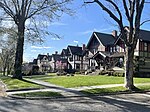Patsy Clark Mansion

The Patsy Clark Mansion is a Spokane, Washington, United States, residence that was designed by architect Kirtland Cutter in 1897 for mining millionaire Patsy Clark. It is located at 2208 West Second Avenue in the city's historic Browne's Addition. The mansion had long been used as a restaurant. In 2002, a law firm purchased the mansion for $1.03 million in order to rescue the landmark from further deterioration. The mansion now houses a law firm, while still remaining open for private rentals for small events. It was listed on the National Register of Historic Places as Clark Mansion in 1975. It is included also as a contributing property in Browne's Addition Historic District.
Excerpt from the Wikipedia article Patsy Clark Mansion (License: CC BY-SA 3.0, Authors, Images).Patsy Clark Mansion
West Pacific Avenue, Spokane
Geographical coordinates (GPS) Address Nearby Places Show on map
Geographical coordinates (GPS)
| Latitude | Longitude |
|---|---|
| N 47.655277777778 ° | E -117.44416666667 ° |
Address
Pacific @ Hemlock (MAC Museum)
West Pacific Avenue
99201 Spokane
Washington, United States
Open on Google Maps











